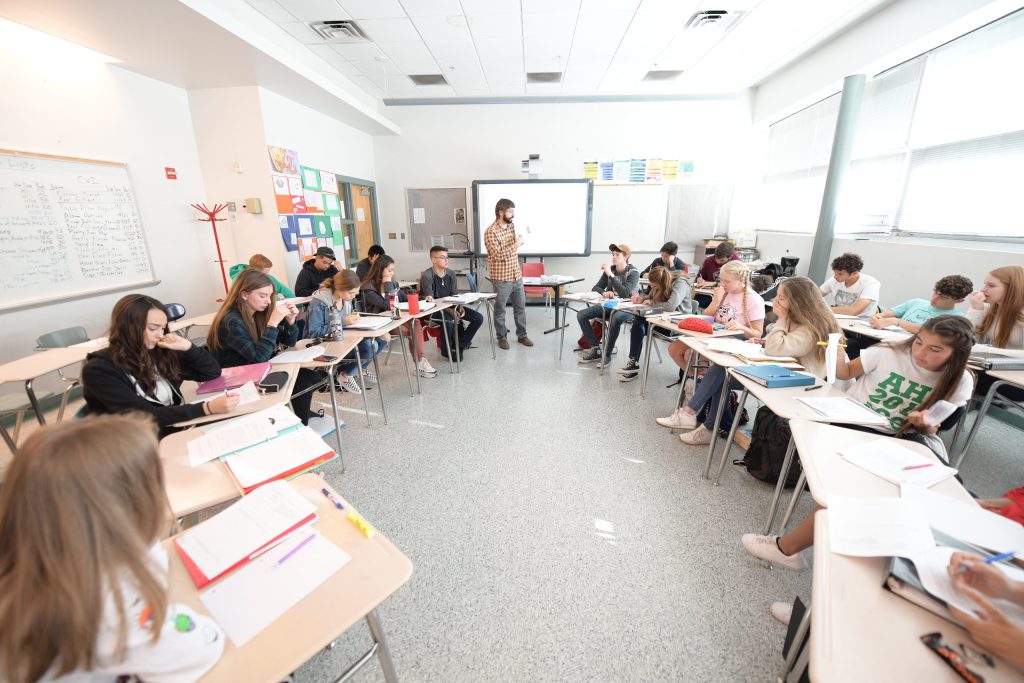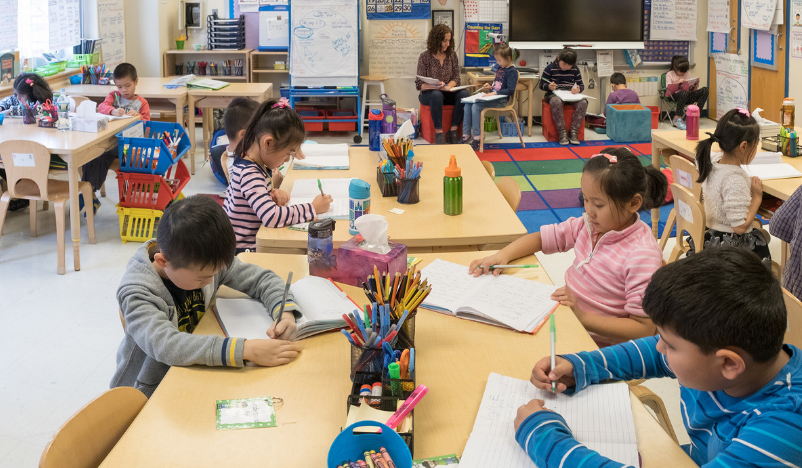Whether you’ve been back to school since July or started school this month, building classroom community is a priority for many teachers at this time of year. Fostering relationships with students is one of the best ways to do this.
To help give inspiration on this topic, we asked teachers during our August #NCTEchat to share an activity that they do at the beginning of the year to build classroom community. So many fantastic responses and ideas were shared! We’ve pulled just a small sampling on common themes to inspire you as you head back to school.
Avoid a Syllabus Review
My team and I are doing a murder mystery day one to get them thinking, interacting, and avoid a boring syllabus review! Check it out here.
Don’t read the syllabus out loud, PLEASE—have students write anonymous questions about the course and the year and engage in real conversation about ideas and expectations and dreams—then chart a path from there.
Set the Tone
To that end, the beginning of the year sets the tone for what students can expect for the months ahead. Does your classroom reflect the hopes and passions of your students? Is it fun? Is it loving?
Prioritize Learning Students’ Names
We spend an entire class period week 1 playing name games. Being able to speak to each other using the first thing you identify with—your name—hopefully makes our class feel less like a room of strangers.
Silly alliterative name game. It gets us laughing and connected right off the bat. Some names stick all year!
We are going to explore our names and the many stories that our names carry with them. Here’s some of the experiences we’re doing on our campus!
Write from Day One
We start by writing our stories. Ss don’t get to share enough & that def. builds community. Also, I do an activity called the “fail test” to demonstrate mistakes are normal, should be celebrated, & part of the learning process. We have great dialogue w/ that one!
Day 1. 10 minute think and write: at what are you an expert or you have specialized knowledge about? We turn this writing prompt into a way of introducing each other. Ss introduce their neighbors. This question becomes year-long blog project.
We watch this video from one of my writing heroes—Donald Graves.
Focus on Identity
I always had kids jump in with 6-word memoirs & then “This I Believe” videos. It helped them self reflect & offered a new lens to their classmates on who they are at this moment in time.
For the past 3 years, we’ve written Where I’m From poems & created identity webs. I’ve connected SS to ELA by discussing the need for community—global & local—with the need for classroom community. We share our work & seek feedback. We build trust.
Visual Autobiographies—Using the book Artists, Writers, Thinkers, and Dreamers as a mentor text, have students create their own visual autobiography. Hang them around the room as gallery art the first month of school!
My students are sketching selfie portraits and filling them in with 50 words that describe who they are. When they are finished, we will decorate the classroom with the portraits and then complete a gallery walk to learn about each other.
I did this identity activity this year and it was amazing! Students made connections to themselves and others in their classroom! Half of the image is their faces and the other is their true identity.
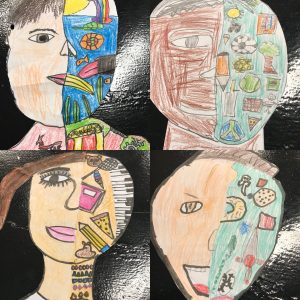
Get Parents Involved
I ask all parents to email me 5 facts about their child. I then read these to the class without using names, and we try to guess who it is. Gets both Ps and Ss engaged in class right off the bat.
Use Music
Building a classroom playlist. I like to give my students the first 3 minutes of class to finish using their phones before putting them up, finishing conversations and jam out before we get to work. Kids are always surprised by each other’s music tastes!
We dance. We welcome students to our community throughout the year, so we dance throughout the year. Kids teach each other traditional dances. I learned not to bump the music too loud and offer some noise cancelling headphones for kids who are audio-sensitive.
My juniors do a Soundtrack to Life assignment. They find titles of songs that explain important people, events, and places of my kids’ lives. I do an example for them first with Michael Jackson song titles, then teach covers of albums with Prince. Kids love sharing this.
Get to Know Your Students
I always ask students about their preferences and interests on a first-day-of-class questionnaire, and then I make sure to incorporate these things into my teaching. Just asking without doing anything with the info makes it seem like busy work.
The first two weeks, I start every class by inviting kids to share things about themselves. Maybe one day it’s the grossest thing they ever ate, another day it might be a place they want to travel. It’s low risk, quick, and generates fun conversation that helps us connect.
For an icebreaker I had students complete a Google Form “Six Things I Should Know About You.” It was very interesting & informative. I learned that one of my student’s entire family bday was in the same month.
Introduce Yourself to Students
My team teachers & I did an @Flipgrid video introducing ourselves & posted it to our website. When the Ss look 4 the supply list they will see our videos and we hope will leave one in return.
I hold a press conference on day one as a way for my students to get to know me. Then they pair up and interview each other and deliver an informal speech introducing their classmate to the rest of the class.
Let Students Get to Know Each Other
I project a list of 20 prompts tied to my class theme (children’s lit), like “1. Fav. Disney character.” Each student makes a 4×5 bingo card & labels each square w/ a number. They have to go around introducing themselves & filling out a box for 20 classmates.
One on One Interviews! More information here.
When I taught 5th grade with @BreakthroughMia this summer, I had each student introduce themselves with a fun fact and then they each filled out a social media profile.
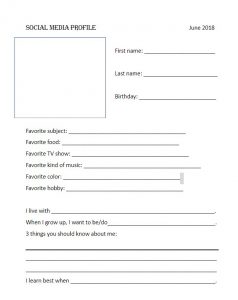
Go with the Classics
I’m bringing back old-fashioned Show and Tell this year.
Write your students a letter and have them write you one back. You can tell them about you, your class, and the year that you will have together.
Work in Groups
They start working in small groups day 1—& it doesn’t stop. We do groups of 2 and 4 w/ each person doing sharing during activities. Scavenger hunts w/ people worked well this year & speed dating w/ class planned. Seating chart will shift to help—I tell them why.
First week of half days I will have a puzzle for the Ss to work together to build. Once it is completed we will hang it up. It will be our first community project. (saw it on Twitter this summer) can’t wait to see it come together.
Get Outside
Time outdoors on those perfect early fall days that aren’t too hot or cold– writing, reading a story aloud, observing nature, mindful walking/listening, acting out a play, review games.
My seniors and I took a walk around campus to the football field to remind them of where they’ve been. Then we hit the classroom and wrote a story they remembered while they were walking.
For the first time, I’m seeking help from an outdoorsy expert to lead Ss in team-building exercises out in the fresh air. I’ll be trying this in #APResearch since peer feedback is so important in that course.
Over the years, I have learned that taking kids to trips to a museum or somewhere outside the classroom for educational purposes can really help create a positive community. If your school collaborates with such programs, take them. In NYC we have #UrbanAdvantage.
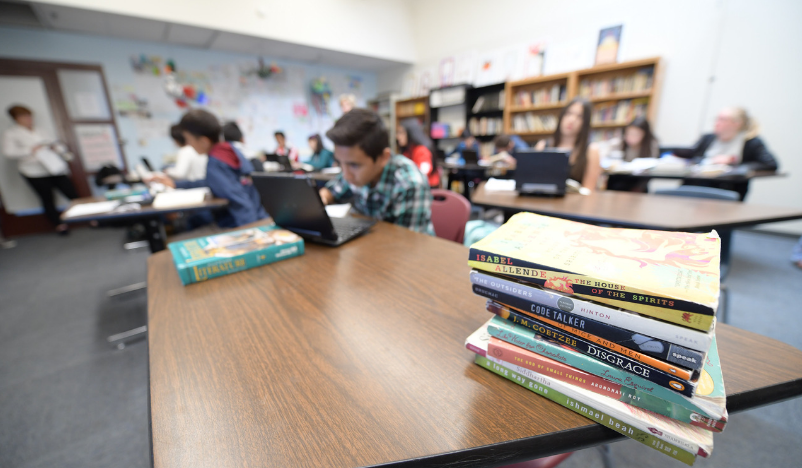
Get Students Excited about Books
The 1st day will be a book tasting. I’ll do a few book talks, but mostly begin conferring as students start searching for a book that fits them. We will also write. I’ll share a poem and kids will respond and share within groups. They will know what’s important.
On the first day I will have many children’s books available—Ss will choose a favorite (either from childhood or one they pick in class) and we will share out what we loved about them. “How do you feel inside when you remember that book?”
For the first 10 days, I’m book talking a book from my top 10 books I read last school year. In no particular order:
1. Warcross
2. The Unwanteds
3. Thunderhead
4. The Monstrumologist
5. The Hate U Give
6. Just Mercy
7. Steelheart
8. Cinder
9. I Am Malala
10. March #3
Talk about Growth, Perseverance, and Even Failure
I don’t rush into teaching content. Nope. Last year we made perseverance Powerpoints. We told stories of perseverance to the class. It was so much fun.
Our 1st day is focused all on our growth mindset theme with a speaker and ice breakers about growth. Introducing growth mindset questions that can pop back up any time in the year when Ss feel like they’re stuck or don’t know they are.
Lots of name games, classroom library book speed dating, and reading the children’s book I Wish You More to talk about the importance of growth mindset and goals for the year!
Last year’s #kaizen card game to demonstrate continuous self improvement was a game changer in my classroom. I plan on doing it again this year. More information here.
We spent a whole class period digging into failure, what it is, how it can help us become better, how I experienced epic failure in my life that led to great things, and how the notion of perfect isn’t something we really want in our class.
Start with Poetry
I want to do some poetry choral reads and then scaffold to group and ultimately individual recitation. I want my students to own poems so no one can take it from them.
I cut out lines of amazing poetry and hang them around the room. Kids do a gallery walk and find lines that engage them. They talk with other people who are engaged by the same lines, and then explain to others why the lines interested or excited or inspired them.
This year, Ss had a chance to ask me ?s & lots of chances to talk to each other. We all wrote poems introducing ourselves & participated in Poetry in Motion. And you know we did some book speed dating!
Keep it Funny
This past week we did some low stakes discussions with Would You Rather? We laughed a lot. We also do some writing about what a bad classroom environment/discussion would look like. They get creative with that one.

